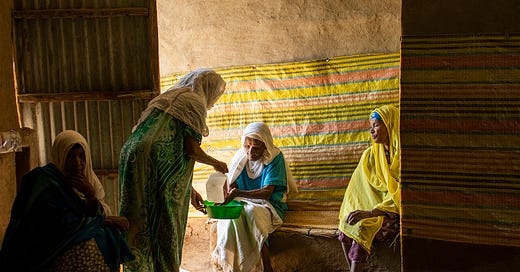By the stretch of her palms, the woman being served reaches not just for water but for the elimination of an inner drought. The women who sit on either side of the frame appear still by habit, fully capable of waiting interminably. I speculate and exaggerate in both cases, but this is the reach inspired by the warmth of the photograph—a warmth in the way sunlight passes into a yellow both muted and luxuriant, and in the scarf. And in the unadorned anteroom where the women sit unforced, such that the photograph becomes too small to contain the aggregate of their tender lives.
Maheder Haileselassie: “Photographs provide information and information is knowledge, which we always say is power.”
The photograph was taken in the Awramba community, Amhara region, Ethiopia.
I first went to Awramba in 2016 and was fascinated by how the community managed to build a system for itself. During my two weeks stay there, I was also able to photograph an elderly home where they assist and support the elders in the community.
I don't believe that older people are protected and treated fairly by the system in Ethiopia. They're vulnerable but less talked about in public. Being in a community that takes care of its older people was fascinating to me.
In my approach to photography, I don't think I have developed a single style. I'm always interested or distracted by different kinds of knowledge I come across and that affects my approach. I like documentary photography but not in the very traditional form.
Photographs provide information and information is knowledge, which we always say is power. It's not just about the audience but also the photographer itself. It has this influence on you, so that if you have good intentions, it makes you become a better person. It makes you see people better and helps you understand and question your surroundings.
More photographs by Maheder Haileselassie
See more of Maheder’s work on her website, where she describes her work as follows:
As an Ethiopian photographer, I welcome the opportunity to document women's issues, showcase or celebrate communities that are finding paths to self sufficiency, explore rural/urban challenges and potentials that involve youth, health, agriculture or technology.
The featured photograph is part of her series on a community of 500 in northwest Ethiopia, which is further contextualized here.
Last week: Katia Golovko
In Dakar I walk around the city and watch. The photographs I take are results of a long-standing observation of urban life and its continuous changes. For a long time I have been attracted to some situations or urban installations and finally I managed to find words to describe what I was looking at and what I was searching for in this city. I am interested in the ways of ‘resisting violence’ by the city itself, by people, by the architecture and by their interaction. The violence of predatory constructions, violence of capitalism, violence of humans to each other and their environment. These forms of resistance finally take shape in unexpected ways of living the city, in its multiple and creative emanations.
Read Place du Souvenir Africain, Dakar.
Thank you for reading and sharing this feature on Maheder Haileselassie. Follow her work on Instagram. Every week I feature one photograph and the photographer who took it. You’ll read a short caption from me, and a statement from the photographer. My goal is to set up conversations with the work of early to mid-career African photographers. You can support the newsletter by asking anyone—or 10 people!—interested in the impact and meanings of photography to subscribe. And, if you know of any photographer whose work is deserving of attention, please email me with their name(s).





